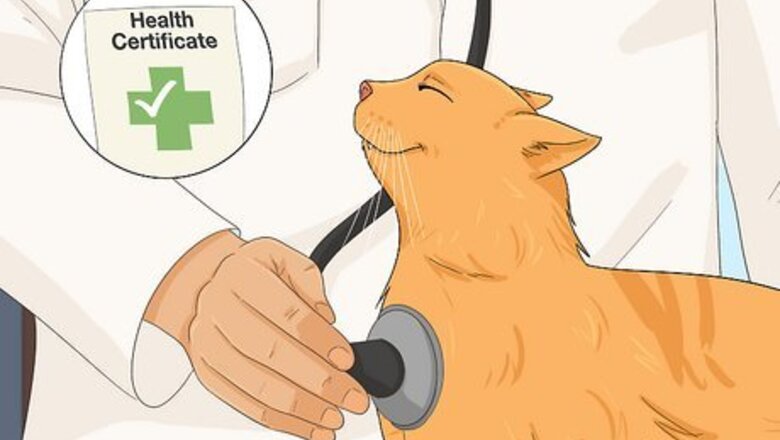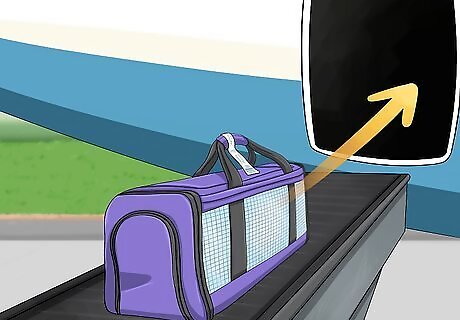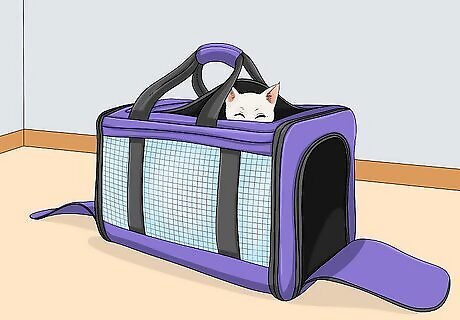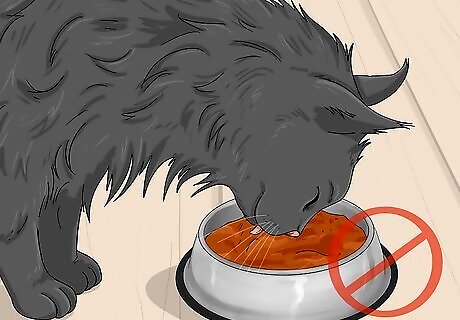
views
- Book an appointment with your vet to make sure both your cats’ vaccinations are up to date and they’re healthy enough to travel on a plane.
- If your cats weigh under 14 kilograms (31 lb) and can share a confined space, they may be able to share a carrier. Check your airline’s in-cabin requirements.
- When going through TSA, remove your cats from the carrier and walk through the x-ray machine. Follow the TSA officer’s instructions during screening.
Getting a Health Check for Your Cats

Book an appointment with your vet and ask for health certificates. Most airlines require a valid health certificate completed by your vet at least 10 days before the flight. This certificate proves that a cat is healthy enough for travel and that all their vaccinations are up to date. Carry this along with your cat’s vaccination records on the plane and throughout the airport. Generally, vet fees can range from $100 to $500 per pet. If you’re traveling internationally, your cats may need to be microchipped and get a rabies vaccination between 21 days and 1 year before travel. Use this tool to see each country’s requirements. Most states in the U.S. require a health certificate and may ask you after you get off the plane. To see each state’s rules, use this tool.

Talk to your vet if your cats get overly stressed when traveling. A vet might suggest getting a thundershirt, which can swaddle your cat and reduce their anxiety. They might also suggest buying a pheromone spray or wipes to use on the carrier to help lower their stress. If one or both of your cats have motion sickness, talk with your vet about ways to reduce their nausea while on a flight. In extreme cases, vets might prescribe a medication to reduce anxiety. Test the medication at home before the trip so you’ll know how your cat will react to it. Sedating or tranquilizing your cats can put them at risk of lung and heart problems at high altitudes. Many airlines will not accept sedated or tranquilized animals.
Booking the Flight

Book your flight early to ensure your cats have spots in the cabin. Some airlines restrict how many pets can travel in the cabin on each flight. In addition, try to book a non-stop flight when possible and avoid the heavy traffic of weekend or holiday flights. Most airlines require domestic cats and dogs to be at least 8 weeks old to travel. Most airlines consider pet carriers as either a personal item or carry-on item.

Consider traveling with your cats in-cabin in one carrier. Most pet travel fees range from $90 to $200 per pet or per carrier. Many airlines allow two cats to share one carrier if they’re under 14 kilograms (31 lb). Review your airline’s animal travel regulations for more information. 2 adult animals that weigh less than 14 kilograms (31 lb) that are similar in size can be put in the same carrier. Animals over 14 kilograms (31 lb) have to be in individual carriers.

Pay for 2 seats in-cabin if your cats can’t share a carrier. If your cats can’t share a confined space for a long time, consider placing them in separate carriers. Depending on your airline’s policies, you may need to purchase an extra seat. Some airlines only allow one pet carrier per ticketed customer.

You can also transport your cats as unaccompanied cargo. If your cats are too large to fly in the cabin, you may have to ship them as cargo. The price of this depends on your destination. Generally, this can cost between $275 to $300 for a domestic flight and up to $1,000 for international travel. The Humane Society of the United States and other animal rights groups recommend against transporting animals as cargo because it can put them at risk of injury or death. You can also hire a pet shipping company using this tool. The cost can be between $2200 and $6400 depending on your destination.

Check the airline’s in-cabin carrier requirements. Most airlines accept hard-sided or soft-sided carriers, however, the size requirements might vary between airlines. Generally, the animal has to be able to stand up, turn around, and lie down comfortably. When flying with two cats sharing a carrier, make sure the carrier is 3 times as wide as the widest part of your largest cat. A soft-sided carrier should be leak-proof with ventilation openings on at least 3 sides.
Preparing Your Cats for the Flight

Teach both cats to ride in the carrier comfortably. To get your cat comfortable with being inside a carrier, start by placing the carrier in an area where your cats spend a lot of time. Place comfortable bedding and a favorite toy inside. Feed your cats near the carrier. Gradually move their food closer to the carrier until they eat comfortably next to it. Then, move the food bowl inside the carrier. Leave tasty treats in the carrier for your cats to find each day. Once your cats are comfortable with eating inside the carrier, practice gently closing the door for a few minutes while they’re eating. Close your cats inside the carrier and practice moving them around inside your home. Afterwards, reward them with treats or play sessions.

Attach a luggage tag to the carrier and line it with towels. Attach a luggage tag with your name, phone number, address, and the name of your pet to the carrier. Line the bottom of the carrier with towels or pee pads to absorb any accidents. If your cats wear collars, make sure the tags include your name, phone number, address, and your cats’ updated vaccination information. Carry a photograph of your pet with you during your travels in case they escape from the carrier. Mark the carrier with the words “LIVE ANIMAL” if you’re not traveling with them in-cabin.
Boarding the Plane With Your Cats

Place a familiar blanket on top of the carrier. Take a familiar blanket or towel with you to drape on top of the carrier. The familiar scent can be comforting for cats, especially if they’re feeling anxious. You can also spray the blanket with a pheromone spray 15 minutes before you travel to help them feel safer. Airlines will not allow you to open the carrier during the flight. However, you can reach down to the closed carrier to soothe your cats.

Avoid feeding your cats 4 to 6 hours before the flight. This is to reduce any nausea and accidents that your cats might experience during the flight. Give your cats a short drink of water and some exercise immediately before placing them in the carrier. You can bring solid or moist cat food in your carry-on bag in case there’s a delay. Check with your airline to see their guidelines on feeding animals on a flight. Consider trimming your cats’ nails before the flight to make sure they can’t damage the carrier or accidentally harm you when going through TSA and boarding the flight.

Remove your cats from the carrier when going through TSA. Place the carrier on the belt so it can be x-rayed. Carry your cats through the screening process and follow TSA officers’ instructions. Once you’re done, return your cats to their carrier away from the security checkpoint. In some cases, your cats might be able to walk through the screening process if they’re wearing a harness and leash. A TSA officer may give you an explosive trace detection swab to make sure there’s no explosive residue on your hands.


















Comments
0 comment